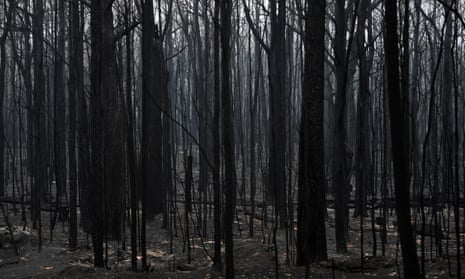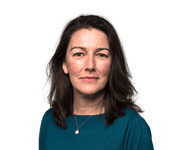There’s a midden at Murramarang on the south coast that dates back to the ice age. It holds the stories of 12,000 years of Yuin occupation in layers of stone tools and spearpoints, fish bones and oyster shells.
To get there you walk through a cow paddock along a path worn by the surfers who go down to Murramarang beach. The midden lies in a hollow on the headland, sheltered from the wind, a place to sit and watch the sea and sky.
For thousands of years, Yuin ancestors would gather and feast, sending fire signals to other mobs up and down the coast. My dad used to say he’d like to sit there one night by the fire and see who might come from the shadows to join him. That’s how strong their presence is in that quiet place.
Murramarang was right in the middle of the fire zone, about 18km south of Ulladulla near Bawley point, where the fires burned all the way to the sand in early December. I want to hope the midden is intact, but unlike the prime minister I don’t believe in miracles. The fires were too ferocious.
Growing up Aboriginal on another mob’s country is a lifelong double dislocation. We belong somewhere else but despite being displaced generations earlier by the frontier and all the horrors that followed, wherever we live as First Nations people, we hold a deep love for country and all that belongs to it. It may not be our land but we love and care for it just the same.
My family ties are in the far west of NSW, where drought, dead rivers and dust storms are destroying our totems and sacred places. But I grew up in the beautiful south and it is the home of my heart.
When I was a kid, Ulladulla was the worker’s paradise holiday spot, not a glamour destination. It swelled to bursting in holiday times but it always seemed that visitors preferred the north coast which had, I was told, warmer water and more things to do when it rained, which it often did down south, even in the middle of summer. But I loved the cold ocean, the empty beaches, the bracing southerlies that ended a hot summer day, usually bringing rain or relief.
On Saturday they just delivered chaos.
In my early teens, my best friend and I went bushwalking with a seemingly ancient group of adults, including her parents, who we secretly called the Fogies. We liked to pretend we were being dragged along but we loved being in the bush, on day-long walks through Moreton national park, trekking along escarpments and slipping into rainforest gullies, with creeks (and leeches) and caves rich with rock art. There were no miracles to be had there either: the fire roared though just after Christmas and on through Nowra into Kangaroo Valley.
I was holidaying with my family at Jervis Bay on New Year’s Eve, in the little house we go to every year. The power kept dimming as the sky went red and quickly black, and the street lights came on at two in the afternoon. I felt the terror of receiving an RFS text that told me it was too late to leave and to seek shelter. A pyrocumulus formed as we stood and watched, thunder rolled and ashy rain fell.
Some of these places have never burned, not once in my lifetime, let alone all at once. Like you, I’ve watched in anguish and horror as fire lays waste to precious Yuin land, taking everything with it – lives, homes, animals, trees – but for First Nations people it is also burning up our memories, our sacred places, all the things which make us who we are.
It’s a particular grief, to lose forever what connects you to a place in the landscape. Our ancestors felt it, our elders felt it, and now we are feeling it all over again as we watch how the mistreatment and neglect of our land and waters for generations, and the pig-headed foolishness of coal-obsessed climate change denialists turn everything and everyone to ash.
Psychologists talk about the phenomenon of climate grief and the need to confront the reality we face head on. Well, we are all confronting it now, and there is no end in sight to this catastrophe.
We have to help each other mourn for what we all love and are losing day by day. But it is not too late to seek solutions from First Nations people who, if you care to ask, know how to do cultural burning to keep the fuel load down, and know where and when to do them.
Ask the First Nations people who are on the frontline on the south coast, like the Yuin crew of the Wreck Bay RFS, who fought blazes out the back of my home town for days over Christmas, and ask the others who are cooking meals, evacuating elders and opening their doors to people who have nowhere else to go.
We know what it feels like to lose everything. And we know the rage of helplessness in the face of government indifference. Maybe this summer is the turning point, where our collective grief turns to action and we recognise the knowledge that First Nations people want to share, to make sure these horrors are never repeated.
Our precious country needs us.

